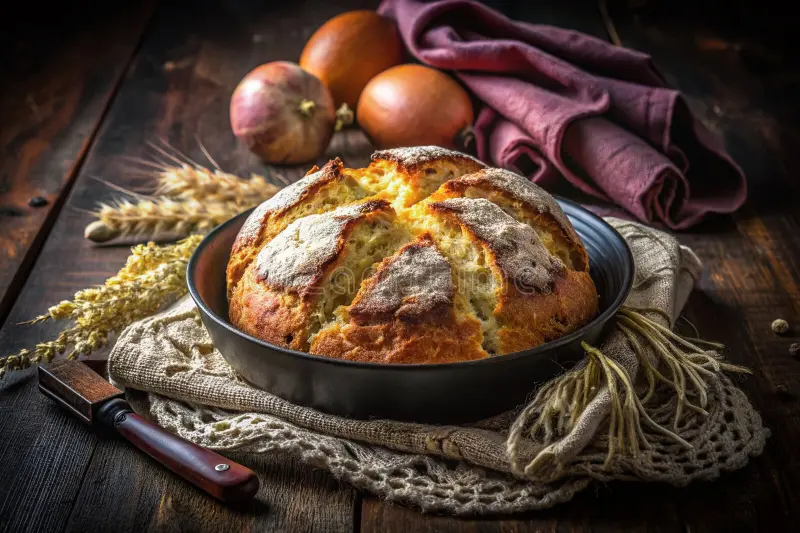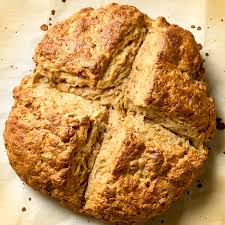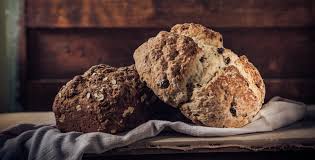
The Fascinating History of Irish Soda Bread: From Humble Beginnings to Global Icon
No discussion of soda bread is complete without a nod to its storied past. Born out of necessity in the rugged landscapes of 19th-century Ireland, this quick bread revolutionized baking for generations of families facing economic hardship. The story begins in the 1830s, when bicarbonate of soda—affectionately known as “bread soda”—first arrived on Irish shores as a cheap, innovative leavening agent. Before yeast’s temperamental rise, bakers relied on this unassuming powder to create fluffy loaves without the wait, making it a game-changer for impoverished households.
The earliest documented Irish soda bread recipe dates back to 1836, published in The Newry Telegraph, a modest Northern Irish newspaper. This pioneering formula called for just four humble ingredients: flour, salt, baking soda, and sour milk (the precursor to modern buttermilk). Why sour milk? In an era without refrigeration, it was a resourceful way to activate the soda’s rising power through natural acidity, yielding a tender crumb without fancy equipment.

As the Great Famine ravaged Ireland in the 1840s, soda bread became a symbol of resilience. Families baked it daily on cast-iron griddles over open fires, its cross-shaped score not just for even baking but, legend has it, to ward off evil spirits or bless the bread for the household. Irish immigrants carried this tradition across the Atlantic, embedding it in American culture—think St. Patrick’s Day feasts where emerald-green versions steal the show.
Today, soda bread’s evolution reflects global influences. From the U.S. where it’s often sweetened with raisins, to modern twists incorporating whole grains for health-conscious eaters, its core remains unchanged: simple, versatile, and soul-warming. For a deeper dive into its cultural roots, check out the Society for the Preservation of Irish Soda Bread—a treasure trove of vintage recipes and folklore.
But what elevates Irish soda bread above ordinary loaves? It’s the alchemy of science and tradition, turning pantry staples into something extraordinary. As we explore its unique makeup, you’ll see why this bread has endured for nearly two centuries, captivating palates worldwide.
Soda Bread’s Irish Roots: Folklore and Evolution
Delve deeper into the lore, and you’ll uncover tales of “barmbrack” (a fruity cousin) and “boxty” (potato-infused variants), showcasing Ireland’s inventive spirit. By the late 1800s, commercial baking soda made it accessible to all, but purists insist on the original “farls”—wedge-shaped pieces baked on griddles. This evolution from survival food to celebrated delicacy underscores soda bread’s timeless appeal, a testament to Irish ingenuity.

For more on its journey, explore Wikipedia’s entry on soda bread, which traces its spread beyond Ireland to Scotland and even Native American influences.
What Makes Soda Bread So Special? Unpacking the Magic Ingredients
At its heart, soda bread is a symphony of simplicity, relying on chemical leavening rather than yeast for that signature rise. No proofing, no fuss—just mix, shape, and bake for a loaf that’s crusty on the outside, tender within. The star players? Baking soda and buttermilk, which react to produce carbon dioxide bubbles, creating lift in under an hour.
Key ingredients include:
- Flour: All-purpose or whole wheat for nutty depth.
- Baking Soda: The leavener that gives it its name and fluff.
- Salt: Enhances flavor without overpowering.
- Buttermilk: Tangy acidity activates the soda, adding moisture and that irresistible sour note.
This no-yeast approach makes Irish soda bread ideal for impromptu baking sessions. Unlike dense yeasted breads, it’s forgiving—perfect for beginners yet sophisticated enough for gourmet twists. Curious about essential baking tools? Head over to our Baking Essentials Guide for must-haves like cast-iron skillets.
The result? A bread that’s not just delicious but versatile: slathered with butter, dunked in stew, or transformed into croutons. Its low-gluten development keeps it chewy, not tough, ensuring every bite bursts with flavor.
Master the Classic Irish Soda Bread Recipe: Step-by-Step Perfection
Ready to bake your own slice of Ireland? This authentic Irish soda bread recipe yields one glorious 8-inch loaf, ready in 45 minutes. It’s foolproof, scalable, and endlessly adaptable—proving that the best recipes are the simplest.
Ingredients for Timeless Flavor
Gather these pantry heroes:
- 4 cups (500g) all-purpose flour (spooned and leveled)
- 1 teaspoon baking soda
- 1 teaspoon salt
- 1 ¾ cups (about 420ml) buttermilk, at room temperature
Optional add-ins for flair: 1 cup raisins or currants for sweetness, or caraway seeds for an herby kick.
Instructions: Bake Like a Pro
- Preheat and Prep: Crank your oven to 450°F (230°C). Line a baking sheet with parchment— no need for a fancy pan.
- Mix Dry Ingredients: In a large bowl, whisk flour, baking soda, and salt. This ensures even distribution for a uniform rise.
- Add Wet Magic: Pour in buttermilk, stirring with a wooden spoon until a shaggy dough forms. Don’t overmix—lumps are your friends here, promising tenderness.
- Shape with Care: Turn onto a floured surface, gently pat into a 7-8 inch round (about 2 inches thick). Transfer to the sheet.
- Score the Cross: With a sharp knife, cut a deep “X” across the top—from edge to edge, about ½-inch deep. This lets steam escape for even baking and that iconic look.
- Bake to Golden Glory: Pop in the oven for 30-40 minutes, until the crust is deep golden and hollow-sounding when tapped. Cool on a wire rack for 10 minutes—patience rewards with perfect slices.
Pro tip: Brush with melted butter post-bake for extra shine and flavor. Slice warm and devour! For more quick bread inspiration, visit Sally’s Baking Addiction for Grandma’s Irish Soda Bread.
This recipe serves 8-10, with each slice clocking in at around 200 calories—guilt-free indulgence at its finest.
Troubleshooting Your Loaf: Common Pitfalls and Fixes
Baked a brick? Overmixing develops gluten, leading to chewiness. Solution: Handle gently, like cradling a newborn. Flat rise? Stale baking soda—test it by fizzing in vinegar. If it doesn’t bubble, toss it. With these tweaks, your soda bread will rise like a champ every time.
Irresistible Variations: Elevate Your Soda Bread Game
Why stop at classic when soda bread variations open a world of flavors? From savory cheese-studded loaves to sweet fruit-packed scones, these twists keep things fresh and exciting. Experiment boldly— the base recipe forgives creativity.
Savory Sensations: Cheese and Herb Delights
Infuse your loaf with 1 cup shredded cheddar and 2 tablespoons chopped fresh rosemary for a gourmet upgrade. Bake as directed; the cheese melts into gooey pockets, perfect paired with soup. Or try a garlic-parmesan version: Add minced garlic and parmesan for an Italian-Irish fusion that’s downright addictive.
For bacon lovers, fold in ½ cup cooked, crumbled bacon—smoky, salty bliss in every bite. These savory spins make soda bread a star side dish, elevating weeknight dinners to feast status.
Sweet Indulgences: Fruit and Nut Twists
Swap savory for sweet with 1 cup dried cranberries and orange zest, mimicking luxurious tea bread. Or go nutty: Stir in walnuts and a touch of honey for crunch and depth. For scones, divide the dough into rounds and bake 15 minutes shorter—flaky, portable treats.
Explore more at The Lemon Apron’s Irish Soda Bread Scones, where marmalade butter takes it over the top.
Gluten-Free and Vegan Hacks
Can’t have dairy? Use plant-based buttermilk (almond milk + lemon juice). For gluten-free, swap in a 1:1 blend—risen and tender, no compromises. These inclusive options ensure everyone savors the fun. Check our Gluten-Free Baking Hub for full guides.
With endless possibilities, soda bread variations prove it’s not just bread—it’s a canvas for your culinary dreams.
Unlock the Health Benefits of Soda Bread: Nourish Body and Soul
Don’t let its rustic charm fool you—soda bread packs a nutritional punch, making it a smart choice for wellness warriors. Whole wheat versions deliver fiber for gut health, steady energy, and heart support, with one slice offering 4-5g of fiber to keep you full and fabulous.
Buttermilk contributes probiotics for digestion, while the absence of added sugars keeps calories in check (under 250 per serving). Opt for whole grains, and you boost B vitamins, iron, and antioxidants—vital for immune strength. Compared to white bread, it’s a powerhouse: lower glycemic index for blood sugar balance, plus phytonutrients from flour.
Incorporate seeds like flax for omega-3s, turning it into a superfood loaf. For gut-friendly upgrades, add oats and green banana flour—prebiotic gold for microbiome magic. It’s proof that delicious doesn’t mean depriving—soda bread fuels adventures guilt-free.
Nutritional Breakdown: A Quick Table
| Nutrient (per slice) | Amount | Benefit |
|---|---|---|
| Calories | 200 | Sustained energy |
| Fiber | 4g | Digestive health |
| Protein | 6g | Muscle support |
| Calcium (from buttermilk) | 100mg | Bone strength |
Pair with avocado for healthy fats, and you’ve got a meal that nourishes from within.
Pro Baking Tips for Flawless Soda Bread Every Time
Achieving bakery-level soda bread isn’t luck—it’s technique. Here are battle-tested secrets to sidestep disasters and savor success.
- Freshness First: Use new baking soda; old stuff fizzles out. Test: Sprinkle in hot water—if it doesn’t foam, replace.
- Room-Temp Buttermilk: Cold liquid shocks the soda, killing the rise. Warm it slightly for peak fizz.
- Gentle Handling: Over-kneading toughens it. Stir just until combined—shaggy is sexy here.
- Hot Oven, No Peeking: Preheat fully; steam early on creates crust. Avoid opening the door for the first 20 minutes.
- Cast-Iron Magic: Bake in a skillet for superior heat retention and that enviable crust.

Common mistake? High-protein flour—stick to all-purpose for chew-free tenderness. With these hacks, your loaves will be legendary. For more wisdom, see Serious Eats’ Real Irish Soda Bread.
Bonus: Score deeply—the “X” isn’t decorative; it promotes even expansion, preventing cracks.
Perfect Pairings: How to Serve Soda Bread Like a Gourmet
Soda bread shines solo but soars with companions. Slather with creamy Irish butter for purity, or elevate with smoked salmon and dill for brunch bliss. Hearty stews? Dunk wedges in beef Guinness— the crust soaks up gravy like a dream.
Cheese boards demand it: Pair with sharp cheddar or blue for textural tango. For sweet tooths, strawberry jam and clotted cream turn it tea-time royalty. Vegan? Hummus and roasted veggies create vibrant stacks.
Wine-wise, a crisp Chardonnay cuts the tang; beer fans, reach for a stout. These pairings transform everyday meals into memorable feasts—versatility at its finest.
Explore our Pairing Recipes Collection for themed ideas, from holiday spreads to picnic packs.
Frequently Asked Questions: Your Soda Bread Queries Answered
Q: Can I make soda bread without buttermilk?
A: Yes! Mix 1 ¾ cups milk with 1 tablespoon lemon juice or vinegar; let sit 5 minutes.
Q: Why is my soda bread gummy?
A: Overmixing or dense flour. Use low-protein all-purpose and mix minimally.
Q: How long does it keep?
A: 2-3 days at room temp in a bag; freeze slices up to 3 months.
Q: Is soda bread vegan?
A: Easily—swap buttermilk for a DIY version.
Q: What’s the difference between Irish and American soda bread?
A: Irish is plain and tangy; American often adds sugar, eggs, butter for cake-like sweetness.
For more FAQs, browse BBC Good Food’s Soda Bread Tips.